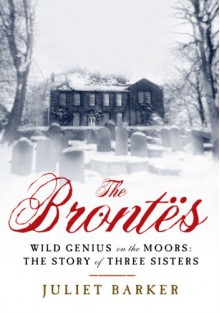
La leyenda literaria de los Brontë empezó con un juego de chicos.
Así lo contaba Charlotte en 1829:
"The play of the Islanders was formed in December 1827 in the following maner. One night about the time when the cold sleet and <?> dreary/ fogs of November are succeeded by the snow storms & high peircing nightwinds of confirmed <?> winter we where all sitting round the warm blazing kitchen fire having just concluded a quarel with Taby concerning the propriety of/ lighting a candle from which she came of victorious no candles having been produced a long pause suceeded which was at last broken by B saying in a lazy maner I dont know what to do this was reechoed by E & A
T wha ya may go t’bed
B Id rather do anything [than] that
& C Your so glum tonight T supose we had each an Island.
B if we had I would choose the Island of Man
C & I would choose Isle of Wight
E the Isle of Arran for me
A & mine should be Guernsey
C the D[uke] of Wellington should be my cheif man
B Her[r]ies should be mine.
E Walter Scott/ should be mine
A I should have Benti[n]ck
here our conversation was interupted by to us dismal sound of the clock striking 7 & we where sumoned of to bed. the next day we added several others to our list of names till we had got allmost all the cheif men in the Kingdom."...para luego empezar a escribirse en libros diminutos improvisados con papel de diario:

Primero les tocó a Branwell y a Charlotte inventar el mundo de
Angria, con héroes de guerra sacados de las noticias que leían en revistas, imitando el estilo pero ofreciendo el original toque de la imaginación de ambos:
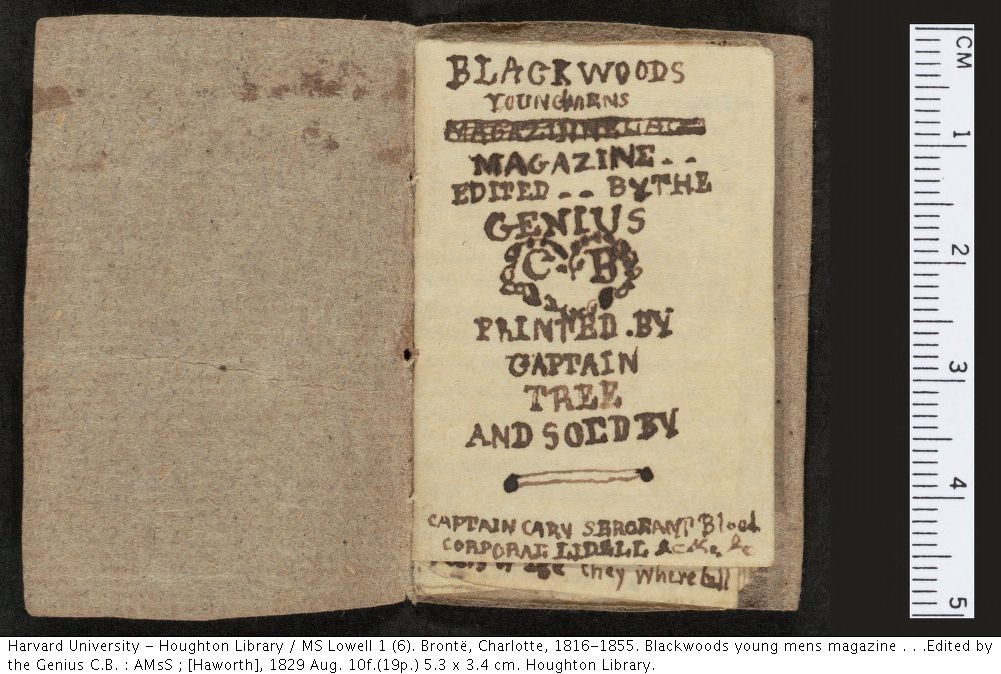 (Fíjense el tamaño: 5cm)
(Fíjense el tamaño: 5cm)Después le llegó el turno a las hermanas más chicas, Anne y Emily, quienes dieron origen al mundo de
Gondal (la fuente de inspiración para el pre-Heathcliff y la pre-Catherine), influenciadas por las aventuras de los libros de Walter Scott y los amores controversiales de las poesía de Lord Byron (ambos ídolos máximos de los hermanos Brontë.)
Las historias evolucionaron hasta el punto en que la fantasía parecía, muchas veces, dominar la realidad. Para los Brontës Branwell, Charlotte, Emily y Anne, el mundo mágico, épico, de personajes heroicos y a veces brutales, era más apasionante que la vida misma, que la vida en aislamiento en el
parsonage 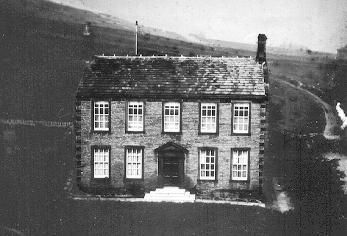
....los chicos, introvertidos, inocentes y mimados por un padre viudo (la madre había muerto de cáncer poco después de nacida Anne) y una tía soltera (sin contar a los escasos empleados, que eran familia también), inventaban la vida y la aventura por escrito, prefiriendo siempre el mundo de la imaginación al de la vida común.
Pero los chicos crecen, y esos hermanos tan unidos en el mundo de la fantasía y la poesía, crecieron y en el camino, los años adolescentes, los efímeros años adultos, vinieron las obvias separaciones, peleas, y decepciones.
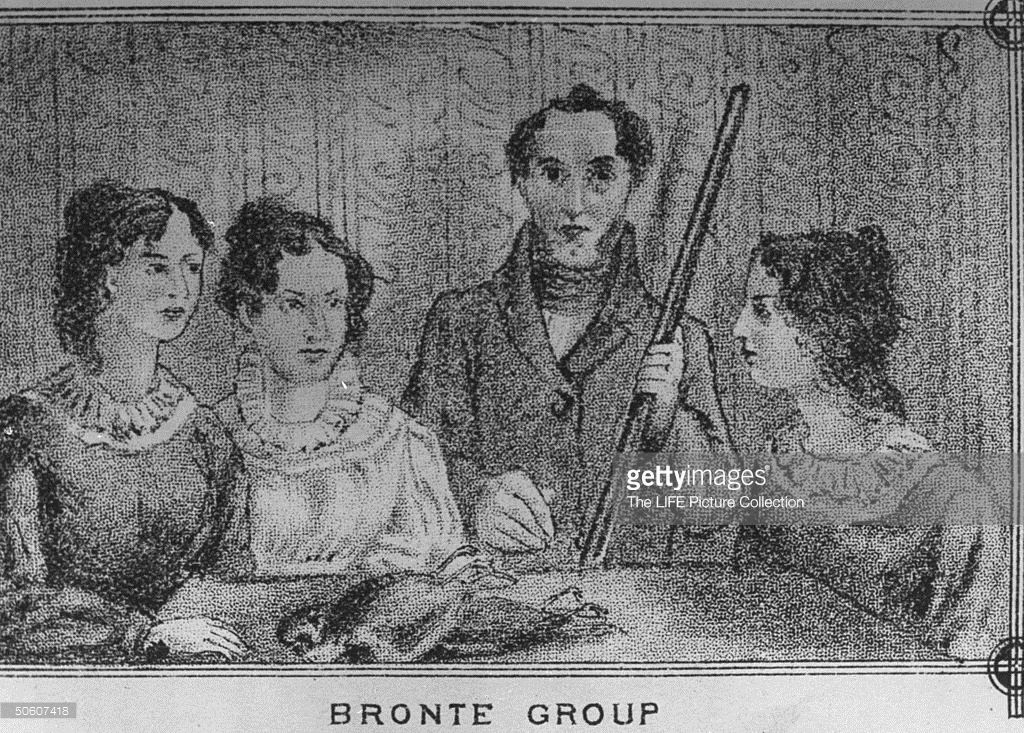
Y, sin embargo, nunca dejaron de ser esos chicos solitarios e introvertidos que encontraban más felicidad en la magia de la ficción que en la áspera verdad de la adultez.
-
Esta biografía es excepcional. Quienquiera que se le atreva a las 1000 y pico de páginas, va a conocer a fondo lo que fue la vida de esta familia. Olvídense de
The life of Charlotte Brontë, la errada biografía que escribiera Elizabeth Gaskell- es esta biografía la indicada -absoluta- para aquellos que quieran conocer en detalle a los Brontë; ésta la que se ocupa en desmitificar por completo a los hermanos y al padre clérigo. Juliet Barker derriba hasta la última leyenda en pie con evidencias más que suficientes. Muestra a cada integrante de la familia como fue realmente. Humanos y nada más.
Desde Patrick Brontë abandonando su país natal, Irlanda, con terror a las revoluciones, buscando la vida pacífica en su religión; pasando por crisis económicas, guerras a lo lejos, matrimonios, muertes (porque hay demasiadas tragedias en la vida Brontë, demasiadas!) y cartas interminables desde Yorkshire hasta Nueva Zelanda. Cada palabra cuenta, cada violación a la intimidad que hiciera hace 150 años, Elizabeth Gaskell, con la ayuda de la "amiga" de Charlotte Ellen Nussey, cada traición es expuesta pero, a fin y al cabo, sirve para retratar quienes fueron estas personas. La traición que cometieran los mal llamados amigos de Charlotte son los que, el día de hoy, sirven para demostrar la humanidad de estos artistas.
Charlotte, la gran protagonista. La primera en tocar la fama con las manos.
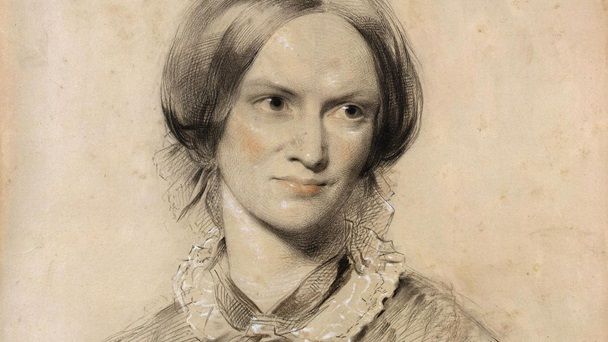
Egoísta, intelectual, guardiana, (y a la vez lo contrario) de sus hermanas , enamorada no correspondida que transformaba sus pasiones en literatura; la mujer que buscaba el reconocimiento a costa de cualquiera, la que pusiera en boca de Jane Eyre el "yo quiero ser tu igual" pero que perseguía el amor para someterse a él y quien, en los últimos meses de su vida, encontrara la felicidad total en el matrimonio con un clérigo "aburrido" y no en las letras que tanto bien le habían hecho de niña.
Branwell,
the promise betrayed,
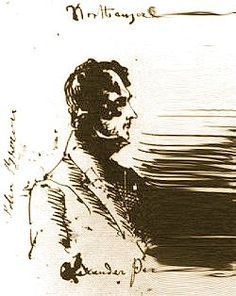
el artista que nunca fue, autodestruyendose en alcohol y el opio; el gran orgullo de su padre y sus hermanas cuando era chico; quien, de grande nunca, por más esfuerzo que le puso (que está bien demostrado en este libro que el pobre adicto siempre luchó por no dejarse estar), no logró el éxito ni el amor que tanto deseaba, traicionado por una amante maldita (Mrs. Robinson, irónico el nombre para una mujer mayor y casada que no hizo más que aprovecharse de un joven prometedor para lueg contribuir a arruinar su vida, pagando sus adicciones) y por su propia imposibilidad para darse a conocer sin dejar su arrogancia de lado. Nunca malvado, siempre soberbio.
Emily, las más misteriosa de los cuatro. No porque guardara algún secreto, ni porque tuviese una doble vida; sino porque su vida era pura y exclusivamente su ficción: Gondal, el mundo de fantasía que creara con Anne. No se puede saber mucho sobre lo que sentía o pensaba, porque , efectivamente, Emily no
vivía ni pensaba más allá de Gondal. Sus historias (junto con sus perros) eran su gran alegría. Su Heathcliff y su Catherine, inspirados por su amor a las historias de Walter Scott y por las mismas historias de Branwell y Charlotte. (Sin la influencia de Branwell, quizá los libros jamás hubiesen existido), su amor por lo brutal que Charlotte tanto buscaba esconder del público (se da a entender que Emily había escrito una segundo novela pero Charlotte, para cuidar la reputación de su adorada hermana, tan devastada por la crítica por sus "personajes horrible", puede haber quemado el manuscrito antes de que otros pudiesen leerlo.
Y Anne, probablemente, la más sensata de todos. Cuando sus hermanos preferían ahogarse en la lástima por ellos mismos, era ella quien se levantaba y actuaba; la primera en buscarse trabajo y mantenerlo como se debe; la que escribía historias sin hacerle asco a las verdades. Hecha y derecha, menospreciada injustamente por Charlotte, negandose a dejarse manejar por ésta. Una genia menospreciada. La gran promesa que no tuvo tiempo de ser: injustamente olvidada, casi borrada (en parte por culpa de Charlotte, que se negaba a reconocer su talento, incluso después de su muerte). Juliet Barker demuestra a través de versos sin editar, la fuerza de voluntad y estilo propio que Anne tenía.
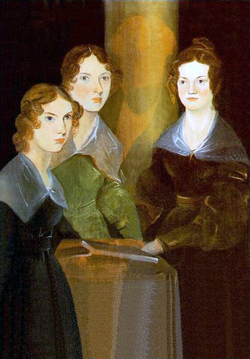
Leer esta biografía tan extensa, tiene a veces el efecto de hacerte sentir estar hablando directamente con sus protagonistas. Yo me sentí así, al menos. Barker no esconde nada, no embellece nada. Todo está expuesto con objetividad. Demuestra a la perfección las verdades que Gaskell (manipulada por la traidora "amiga" Ellen Nussey) prefierió esconder. Como ien dice en algún momento:
"Charlotte and her sisters thus became the dutiful, long-suffering daughters and Branwell the wastrel son of a harsh, unbending father. The portrayal of Charlotte as the martyred heroine of a tragic life, driven by duty and stoically enduring her fate, served its purpose at the time. Charlotte’s wicked sense of humour, her sarcasm, her childhood joie de vivre which enlivens the juvenilia, are completely ignored. So, too, are her prejudices, her unpleasant habit of always seeing the worst in people, her bossiness against which her sisters rebelled, her flirtations with William Weightman and George Smith and her traumatic love for Monsieur Heger. What remains may be a more perfect human being, but it was not Charlotte Brontë.
Mrs Gaskell’s Emily, too, reduced to a series of vignettes illustrating her unusual strength of character, betrays nothing of the obsession with Gondal which made her almost incapable of leading a life outside the sanctuary of her home but led her to the creation of the strange and wonderful world of Wuthering Heights. Anne is simply a cipher, the youngest child, whose boldness in defying convention by adopting a plain heroine in Agnes Grey and advocating startlingly unorthodox religious beliefs and women’s rights in The Tenant ofWildfell Hall finds no place in Mrs Gaskell’s portrait."...y cómo tan injustamente optó por manchar a Bell Nicholls, el viudo de Charlotte y al mismísimo patriarca Brontë, Patrick, con mentiras y falsas evidencias (todas de las bocas de gente envidiosa o resentida por alguna razón u otra).
"Most of all, however, it was the men in Charlotte’s life who suffered at her biographer’s hands. The Patrick Brontë who took such tender care of his young children, campaigned incessantly on behalf of the poor of his parish and espoused unfashionable liberal causes is unrecognizable in her malicious caricature of a selfish and eccentric recluse. Similarly, the Branwell who was his family’s pride and joy, the leader and innovator, artist, poet, musician and writer, is barely touched upon, despite the fact that, without him, there would probably have been no Currer, Ellis or Acton Bell."Es un librazo difícil de leer porque, lo repito, no deja nada de lado. Los detalles a veces pueden resultar pesados o abrumadores, pero, al final, valen la pena leerlos para tener un entendimiento a fondo de cómo vivieron, cómo se sintieron y tristemente murieron los legendarios Brontë.
"More than anything else (...) they had each other. As children they had needed no other companions and in the sometimes heated, often intense, but always affectionate rivalry between them, they had each found a place and a voice. Even as adults they tended to exclude others: though self-sufficient as a unit, they were dependent on each other for the mutual support and criticism which underpinned their lives and illumined their literary efforts."Al final de todo, ya sin las escritoras prodigiosas ni la promesa fallida del hijo, solos Patrick y el yerno Arthur contra el mundo, injustamente criticados y señalados debido a la publicación del libro de Gaskell. Solos para pelear por la memoria de los fallecidos y el respeto a la privacidad de una familia por siempre destinada a la leyenda.
Juliet Barker les da la oportunidad de reinvindicarse...una chance tan merecida para ellos! Branwell, condenado a ser un artista misterioso olvidado en adicciones, es, con justicia, es bien representado como un pobre pibe con aspiraciones que nunca pudieron ser (tanto en el arte como en el amor.) Ni tan maldito ni tan santo, sólo humano. Charlotte, que antes fuera una santa aburrida y sola, es introducida como una mujer capaz, con muchos defectos y egoísmos propios de un temperamento tan genial como problemático. Emily, el mayor misterio, desmitificada, presentada como una chica simple que prefería los héroes brutales de su amado Walter Scott a la vida social del afuera. Anne, la olvidada, ahora revivida como una cristiana cuasi feminista, que en sus libros y poemas fue más bisagra que Charlotte, más valiente, más inteligente y práctica, sus corajes más osados, sus historias mucho más realistas y menos románticas, tanto en la vida como en la literatura. Y, finalmente, Patrick, pintado por Ellen Nussey (y en consecuencia, por Gaskell, quien, en las palabras de Patrick : "
“Well, I think Mrs Gaskell tried to make us all appear as bad as she could”.) como un tirano sin sentimientos, tanta injusticia, en esta biografía es el padre solo, de una inteligencia admirable que supo criar hijos geniales, dándoles todo el amor; después de ellos,
triste, solitario y final, acompañado por la inquerantable amistad de MR. Charlotte Brontë, es decir, el viudo Arhtur Bell Nicholls.
Los Brontë, personas de carne y hueso, a veces más llenos de fantasías y sueños que de realidad. Aislados pero juntos, al final, en el paisaje de cumbres borrascosas que envuelve a la magnífica casa BrontË, en Haworth.
Muchas lágrimas, y mucho amor para ellos, que por siempre van a ser inolvidables. Los amo hasta el fin. Y (aunque sé que Barker nunca va a leer esto) igual, gracias a vos, genia total, biógrafa soñada, por semejante libro. Las Brontë (al menos Charlotte, Patrick y Branwell) seguro te estarían muy agradecidas.
(Reseña con links de interés y fotos explicadas en La Loca de los Libros.)


 Log in with Facebook
Log in with Facebook 











